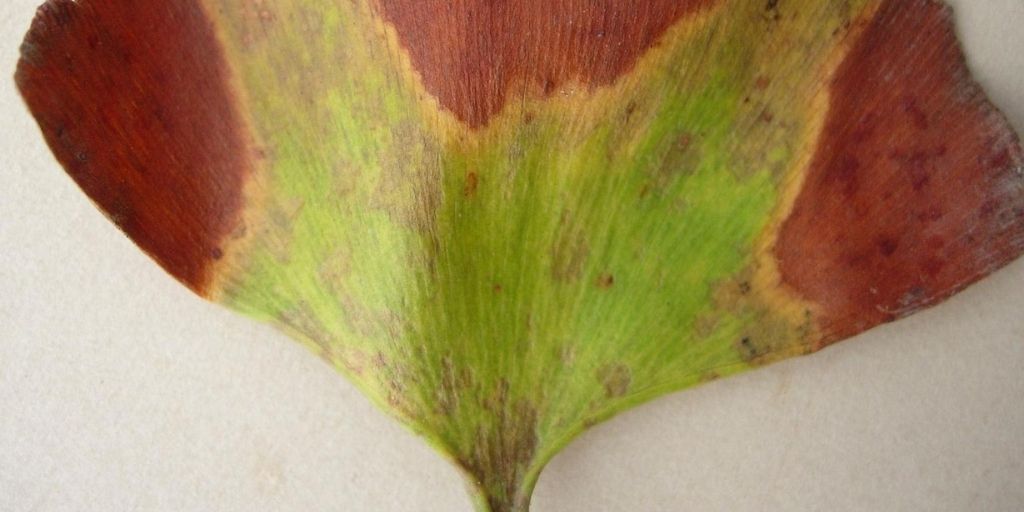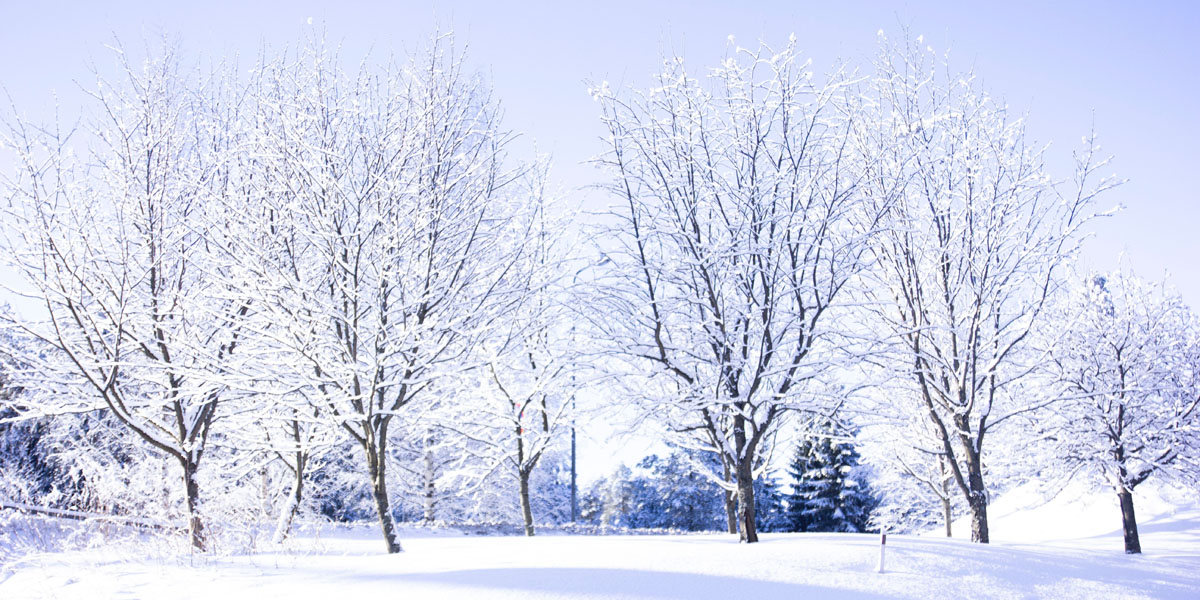If your tree’s leaves look like they’ve been scorched, it could be due to typical late-summer heat stress and water stress. As leaves struggle with too little water and too much heat, the leaf edges turn brown and look dried up or scorched.
But, although they look similar, typical summer leaf scorch is very different from Bacterial Leaf Scorch (BLS), a fatal bacterial disease that’s killing trees throughout New Jersey.
In this article we cover:
- What Bacterial Leaf Scorch is,
- The cause of BLS and how it spreads,
- Symptoms to look out for,
- How to prevent BLS from infecting your trees,
- Treatment and mitigation options, and
- What to do if you suspect your tree has Bacterial Leaf Scorch.
About Bacterial Leaf Scorch (BLS)
Bacterial Leaf Scorch is a disease that attacks and eventually kills trees throughout New Jersey. It’s caused by a bacterium called Xylella fastidiosa, the same bacteria that causes Pierce’s disease in grapevines.
Once this bacterium enters a tree, it spreads rapidly throughout the entire tree. As it spreads, it destroys the tree’s water-transporting system (the xylem) that pulls water up from the soil and delivers it to each leaf.
BLS has no cure; once a tree is infected, there’s no way to stop the spread of the disease.

Bacterial leaf scorch can be identified by the yellow border between the green and brown of the affected leaves, as shown in this picture of a ginkgo leaf. Image courtesy of Elizabeth Bush, Virginia Polytechnic Institute and State University, Bugwood.org.
Symptoms of Bacterial Leaf Scorch
When a tree becomes infected with BLS it can take several years before the disease becomes evident. When it does, it looks just like the name suggests – the leaves look like they’ve been scorched.
At first, symptoms are limited to a few leaves or one branch. But, over time, more areas of damage appear until the entire crown is covered with scorched-looking leaves.
BLS damage shows up in late summer when regular leaf scorch from heat and drought stress is also present. This can make it difficult to distinguish from water and heat stress damage.
There are, however, two ways to tell whether the damage you’re seeing is likely to be BLS –
- Location of the damage – If the wilting and yellowing starts with older leaves and moves upwards to the top or newer leaves, it’s more likely to be caused by BLS. If the newer leaves are affected first, it’s probably water or heat stress damage.
- Pattern of the damage – If the affected leaves have a yellow border between the healthy green part and the crispy brown part, it’s probably a sign of BLS. Different tree species show differing patterns of the disease on their leaves, but the yellow band between healthy and diseased leaf tissue shows up on all infected trees.
For an accurate diagnosis, BLS must be analyzed in a lab. Rutgers University has a diagnostic plant laboratory, and you can find more BLS information on its website.
Look For Symptoms in Summer
Bacterial leaf scorch will stand out on trees when summer weather is mild, and trees are not experiencing drought or water stress.
Healthy, uninfected trees will have full, leafy crowns. In contrast, BLS-infected trees will have scorched leaves despite the ideal growing conditions.
How Bacterial Leaf Scorch Spreads
The Bacterial Leaf Scorch bacterium is spread by insects that pierce tree leaves and suck out sap.
An insect that feeds on a tree infected with BLS sucks in sap that carries the BLS bacterium. When these now-infected insects pierce leaves on healthy trees, they transmit BLS through their saliva to the tree.
The common garden insect pests that transmit BLS include:
- Leafhoppers
- Sharpshooters, and
- Spittlebugs
These insects can travel long distances, taking the BLS bacterium with them and spreading it to uninfected trees.
Once Bacterial Leaf Scorch enters a tree, it rapidly multiplies and spreads up and down the tree’s xylem tubes. BLS clogs the tubes, and the tree will start to decline from lack of water.
Note: Sharpshooter insects get their common name because the leaf surface damage they cause look like tiny bullet holes.
Trees That Are Most Susceptible to Bacterial Leaf Scorch

A pin oak in New Jersey with bacterial leaf scorch. By Famartin – Own work, CC BY-SA 3.0, https://commons.wikimedia.org/w/index.php?curid=32207873 Alpine-oak-bacterial-leaf-scorch.
In New Jersey, it is primarily the Northern red oak (Quercus rubra) that becomes infected with BLS. This happens in forests, as well as in urban and suburban settings.
Other trees in the red oak group, such as pin oak (Q. palustris) and scarlet oak (Q. coccinea), can also be infected with BLS, as can oaks from the white oak group. Several other tree species can also develop Bacterial Leaf Scorch.
Below is a partial list of the tree species in New Jersey that have been confirmed to develop BLS when exposed to the Xylella fastidiosa bacterium.
- Red maple (Acer rubrum)
- Boxelder (Acer negundo)
- Sugar maple (Acer saccharum)
- Flowering dogwood (Cornus florida)
- Hackberry (Celtis occidentalis)
- Sweet gum (Liquidambar stryraciflua)
- White mulberry (Morus alba)
- American sycamore (Platanus occidentalis)
- London plane (Platanus x acerifolia)
- Black oak (Quercus velutina)
- Bluejack oak ( incana)
- Bur oak ( macrocarpa)
- Chestnut oak ( prinus)
- Laurel oak ( laurifolia)
- Live oak ( virginiana)
- Post oak (Q. stellata)
- Shingle oak ( imbricaria)
- Shumard oak ( shumardii)
- Southern red oak ( falcata)
- Swamp white oak ( bicolor)
- Water oak ( nigra)
- White oak ( alba)
- Willow oak ( phellos)
- American elm (Ulmus americana)
Treatment for Bacterial Leaf Scorch
Unfortunately, BLS is always fatal. We do not yet have any effective treatment to “cure” trees infected with Bacterial Leaf Scorch.
However, there is a treatment option that can help manage the symptoms of BLS and slow the decline of infected trees. A special antibiotic can be injected directly into the tree to combat the bacterium that causes the disease. It’s often combined with a substance that thickens the outer surface of the tree’s leaves, making them more difficult for insect pests to pierce.
This treatment needs to be applied by a professionally-trained applicator and requires specialized equipment. But, for mature specimen trees, it can be well worth the effort as it can help maintain the tree for several years, perhaps giving you time to plant and grow a replacement tree.
How to Prevent BLS From Spreading & Infecting Your Trees
It’s almost impossible to completely prevent Bacterial Leaf Scorch from infecting your trees. The insects that spread BLS travel widely and are hard to control. Plus, these insects feed on many shrubs and smaller plants that can also be infected with BLS. This increases the opportunities for leaf-damaging insects to take in the bacterium through infected sap and to spread it to other plants, including your trees.
However, there are several things you can do to limit the spread and damage caused by BLS. These include:
- Planting trees that are resistant to BLS
- Using a mix of tree species in your landscape
- Removing infected host trees and disposing of them safely
- Keeping your trees and your garden healthy and well-maintained
BLS-Resistant Tree Species
Scientists have found that some white oak species are less susceptible to BLS than red oak species and that other tree species have shown some resistance to BLS.
These more resistant trees include:
- Black tupelo (Nyssa sylvatica)
- Beech (Fagus sylvatica)
- Buckeye (Aesculus species)
- American linden (Tilia americana)
- Japanese zelkova (Zelkova serrata)
While it’s good to choose a BLS-resistant tree species, that shouldn’t be the only consideration. Also check the tree’s resistance to the other pests and diseases that damage trees in our area and throughout New Jersey, such as:
Choose a Mix of Trees and Shrubs
Planting a mix of trees in your garden always reduces the spread of disease. Mixed planting and species variety reduce insect infestations.
A healthy garden should always have a mix of plants that attract wildlife, beneficial insects, pollinators, and beneficial predators.
When you attract beneficial insects, insect predators, and songbirds to your garden, leafhopper insects that transmit BLS can be eaten, killed, or parasitized by these garden visitors.
Remove Infected Trees & Replant New Ones
Before you remove trees that are declining from BLS, plant your new resistant tree species first.
This allows new trees to settle in and grow up before you remove larger infected trees. Trees growing together share resources, grow faster and are generally healthier than single, isolated specimens.
Keep Your Plants & Landscape Healthy
Healthy, vigorous trees and landscape plants can reduce the chances of BLS infection. Trees that receive enough water and nutrients are naturally more resistant to pests and diseases, so be sure to:
- Check your irrigation system to make sure it’s working as it should and that all plants are getting enough water.
- Spread and maintain a layer of mulch around your trees and in landscape beds.
- Enrich your soil with compost for nutrients and better water-holding capacity.
- Recognize the signs of nutrient deficiency and ensure that your trees, shrubs, and landscape plants are fertilized when needed.
- Follow our summer tree care tips to prevent unnecessary damage or tree health issues.
- Keep a close eye on trees and shrubs during heat waves and extended periods of hot weather.
- Be especially mindful of recently planted trees to make sure they’re getting all the care they need.
How We Can Help
Bacterial Leaf Scorch is a serious threat to shade trees throughout New Jersey. We can’t yet stop its spread, but there are some things we can do to slow it and minimize damage.
Besides injecting an antibiotic treatment to slow a tree’s decline, we can prune off affected branches on BLS-infected trees to improve their appearance. But, like antibiotic treatment, pruning won’t stop the disease; eventually, it will spread to the rest of the tree.
PRO TIP: If you choose to prune your infected trees, be sure to disinfect your tools between each cut with a bleach solution to prevent spreading BLS to uninfected trees.
If you think you have trees with BLS, contact us right away. The sooner we can help you make a plan to protect or remove them, the better the outcome is likely to be.





